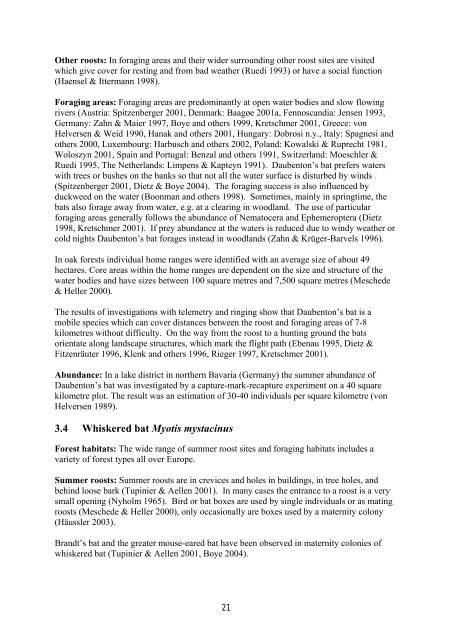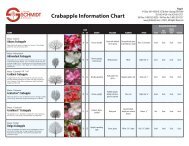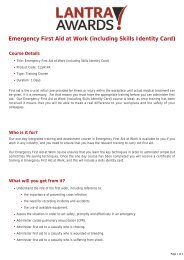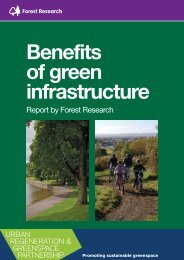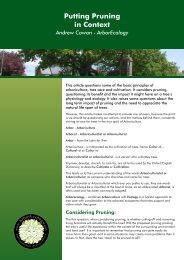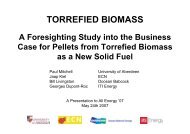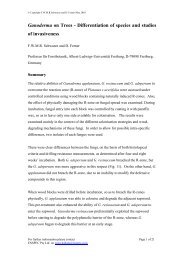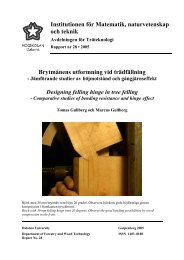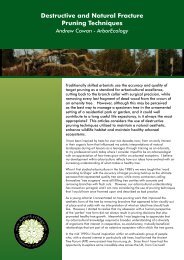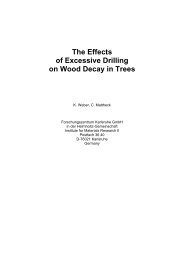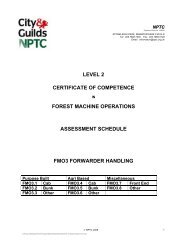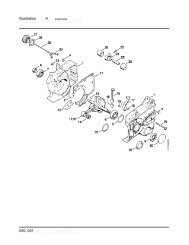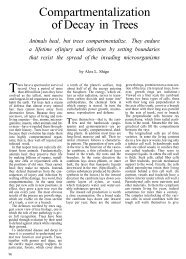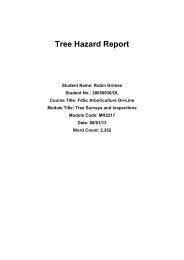Herrenchiemsee Island in Bavaria (Germany) use the whole of the 230 hectare highlystructured island (Meschede & Heller 2000).Foraging areas are close to the summer roosts (distances up to 4.2 kilometres) and theanimals spend about half of their time of activity within a circle around their roost site withthe radius of 600 metres (Bontadina 2002, Holzhaider and others 2002).3.3 Daubenton’s bat Myotis daubentoniiForest habitats: Forests are the main summer roost sites and are also used <strong>for</strong> <strong>for</strong>aging, butthe most important <strong>for</strong>aging areas are ponds and rivers and other water bodies.Summer roosts: Woodlands are most important as roost sites <strong>for</strong> Daubenton’s bat, especiallyif they are close to water bodies. Summer roosts are predominantly in trees, sometimes inwall crevices in buildings or underneath bridges (Moeschler & Ruedi 1995). Preferred roostsare in old woodpecker holes, which become enlarged upwards by rotting within a living tree(European beech Fagus sylvestris, Common oak Quercus robur, European hornbeamCarpinus betulus, European ash Fraxinus excelsior) with a trunk diameter of at least 30centimetres at 1 metre above the ground (Nagel & Häussler 2003, Dietz & Boye 2004).Fissures in stems, wood crevices, hollow branches, and bird or bat boxes are also used. Mostroosts are found in or near the trunk of a broadleaf tree at a height of 1 to 25 metres above theground (Meschede & Heller 2000, Rieger 1996). Roost trees are often situated near the <strong>for</strong>estedge: more than 40% are within 30 metres of the edge (Nagel & Häussler 2003). Most malesroost alone, and in May and June they also use underground roost sites (Degn 1989, Kallasch& Lehnert 1995, Roer & Schober 2001).Summer roosts are changed frequently. Females of a maternity colony switch among anetwork of several roost sites. The occupation of a roost may also change in compositionbetween all males, all females or mixed groups (Dietz & Boye 2004).Summer roosts of Daubenton’s bat are sometimes shared with the noctule, Leisler’s bat,greater mouse-eared bat Myotis myotis, Bechstein’s bat, Brandt’s bat, Natterer’s bat Myotisnattereri, brown long-eared bat or Nathusius’ pipistrelle Pipistrellus nathusii (Rieger 1996,Meschede & Heller 2000, Dobrosi n.y.).Winter roosts: Winter roosts are nearly exclusively in caves, mines, cellars and otherunderground habitats, which have a very high humidity, temperatures above freezing, and nodisturbance by humans (Dietz & Boye 2004). The best temperature of a hibernaculum isbetween 4 °C and 8 °C (Urbanczyk 1991). Large hibernation sites can host several thousandsof Daubenton’s bats (e.g. Segeberg Cave and Spandau Citadel in Germany).Summer and winter roosts may be at a distance of up to 100 kilometres from one another(Roer & Schober 2001), but are more usually within 50 kilometres (Schober & Grimmberger1998).In most hibernation roosts there are also other bat species present, especially those of thegenus Myotis and Plecotus (Dietz & Boye 2004).20
Other roosts: In <strong>for</strong>aging areas and their wider surrounding other roost sites are visitedwhich give cover <strong>for</strong> resting and from bad weather (Ruedi 1993) or have a social function(Haensel & Ittermann 1998).Foraging areas: Foraging areas are predominantly at open water bodies and slow flowingrivers (Austria: Spitzenberger 2001, Denmark: Baagøe 2001a, Fennoscandia: Jensen 1993,Germany: Zahn & Maier 1997, Boye and others 1999, Kretschmer 2001, Greece: vonHelversen & Weid 1990, Hanak and others 2001, Hungary: Dobrosi n.y., Italy: Spagnesi andothers 2000, Luxembourg: Harbusch and others 2002, Poland: Kowalski & Ruprecht 1981,Woloszyn 2001, Spain and Portugal: Benzal and others 1991, Switzerland: Moeschler &Ruedi 1995, The Netherlands: Limpens & Kapteyn 1991). Daubenton’s bat prefers waterswith trees or bushes on the banks so that not all the water surface is disturbed by winds(Spitzenberger 2001, Dietz & Boye 2004). The <strong>for</strong>aging success is also influenced byduckweed on the water (Boonman and others 1998). Sometimes, mainly in springtime, thebats also <strong>for</strong>age away from water, e.g. at a clearing in woodland. The use of particular<strong>for</strong>aging areas generally follows the abundance of Nematocera and Ephemeroptera (Dietz1998, Kretschmer 2001). If prey abundance at the waters is reduced due to windy weather orcold nights Daubenton’s bat <strong>for</strong>ages instead in woodlands (Zahn & Krüger-Barvels 1996).In oak <strong>for</strong>ests individual home ranges were identified with an average size of about 49hectares. Core areas within the home ranges are dependent on the size and structure of thewater bodies and have sizes between 100 square metres and 7,500 square metres (Meschede& Heller 2000).The results of investigations with telemetry and ringing show that Daubenton’s bat is amobile species which can cover distances between the roost and <strong>for</strong>aging areas of 7-8kilometres without difficulty. On the way from the roost to a hunting ground the batsorientate along landscape structures, which mark the flight path (Ebenau 1995, Dietz &Fitzenräuter 1996, Klenk and others 1996, Rieger 1997, Kretschmer 2001).Abundance: In a lake district in northern Bavaria (Germany) the summer abundance ofDaubenton’s bat was investigated by a capture-mark-recapture experiment on a 40 squarekilometre plot. The result was an estimation of 30-40 individuals per square kilometre (vonHelversen 1989).3.4 Whiskered bat Myotis mystacinusForest habitats: The wide range of summer roost sites and <strong>for</strong>aging habitats includes avariety of <strong>for</strong>est types all over Europe.Summer roosts: Summer roosts are in crevices and holes in buildings, in tree holes, andbehind loose bark (Tupinier & Aellen 2001). In many cases the entrance to a roost is a verysmall opening (Nyholm 1965). Bird or bat boxes are used by single individuals or as matingroosts (Meschede & Heller 2000), only occasionally are boxes used by a maternity colony(Häussler 2003).Brandt’s bat and the greater mouse-eared bat have been observed in maternity colonies ofwhiskered bat (Tupinier & Aellen 2001, Boye 2004).21
- Page 3: English Nature Research ReportsNumb
- Page 7 and 8: ContentsPreamble1. Legal aspects...
- Page 9 and 10: 1. Legal aspectsThere are three int
- Page 11 and 12: to the Agreement decided that the c
- Page 13 and 14: Country European Community EUROBATS
- Page 15 and 16: types in Europe where many of the e
- Page 17 and 18: • the European Commission initiat
- Page 19: Foraging areas: Central European sp
- Page 23 and 24: Brandt’s bat travels up to 250 ki
- Page 25 and 26: others 2004). Maternity colonies al
- Page 27 and 28: 1995, The Netherlands: Limpens and
- Page 29 and 30: from a maternity colony covered a t
- Page 31 and 32: hibernaculum is the Levensau Bridge
- Page 33 and 34: female (Fuhrmann and others 2002).
- Page 35 and 36: Foraging areas: In Central Europe f
- Page 37 and 38: Table 2 Importance of tree holes fo
- Page 39 and 40: sites it was found that the possibi
- Page 41 and 42: advancing age of a tree its potenti
- Page 43 and 44: floor up to the canopy and beyond c
- Page 45 and 46: Table 6 Overview of the most freque
- Page 47 and 48: 6.2 2nd step: Active search for roo
- Page 49 and 50: This first approach to a woodland b
- Page 51 and 52: number of tree-dwelling birds in pr
- Page 53 and 54: Types of boxes used by batsThere ar
- Page 55 and 56: oxes exposed to the sun. As an exam
- Page 57 and 58: Con: Bats use bat boxes selectively
- Page 59 and 60: 9. ReferencesABULADZE, A., BUXNIKAS
- Page 61 and 62: BEKKER, J.P. 1990. Ervaringen met v
- Page 63 and 64: BRAUN, M., & HÄUSSLER, U. 2003c. K
- Page 65 and 66: Ökologie und Verbreitung von Arten
- Page 67 and 68: (Germany). In: PRIEDE, I. G. & SWIF
- Page 69 and 70: (Nyctalus leisleri) sowie zur Besie
- Page 71 and 72:
HEISE, G. 1985. Zu Vorkommen, Phän
- Page 73 and 74:
JONES, G. 1990. Prey selection by t
- Page 75 and 76:
(Chiroptera: Vespertilionidae). - P
- Page 77 and 78:
Ökologie und Verbreitung von Arten
- Page 79 and 80:
PÉREZ, J. L. & IBÁÑEZ, C. 1991.
- Page 81 and 82:
ROTTMANN, R., BOYE, P. & MEINIG, H.
- Page 83 and 84:
SCHORCHT, W., and others. 2002. Zur
- Page 85 and 86:
STUTZ, H.-P. B. & HAFFNER, M. 1989.
- Page 87 and 88:
WAGNER, M., KERTH, G. & KÖNIG, B.
- Page 89:
10. AuthorsDr. Peter Boye became fa


